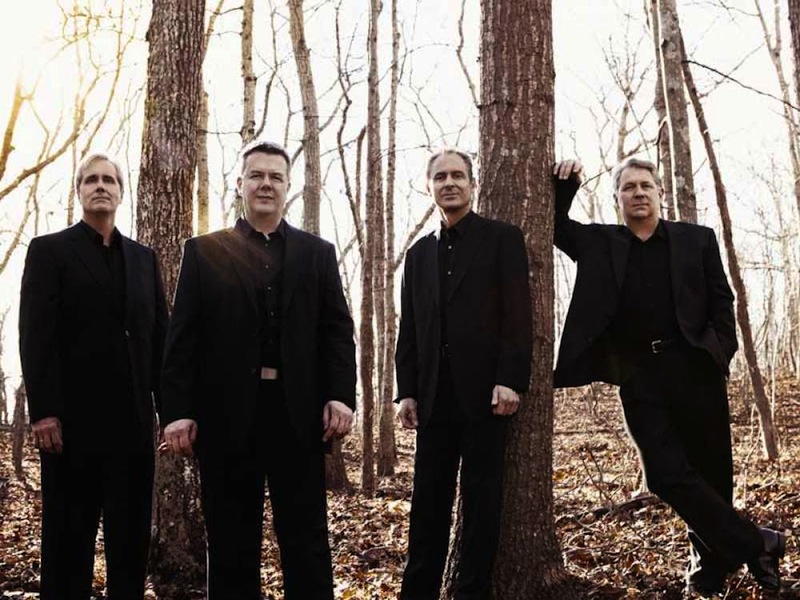Emerson Quartet brings warmth and expressive weight to Beethoven, Grieg and Shostakovich

The Emerson Quartet performed Sunday night at the National Museum of Natural History. Photo: Lisa-Marie Mazzucco
The Emerson String Quartet was long known for a steely, laser-focused sound. Since the personnel change at the end of the 2012-2013 season, with Paul Watkins replacing David Finckel as cellist, the group has been adjusting that sonority. Sometimes the results have been better than others, with troubles surfacing this past summer. Judging by the second of the group’s appearances on their annual Smithsonian Associates series, heard Sunday night at the National Museum of Natural History, the Emerson Quartet seem to have turned a corner for the better.
Indeed this was one of the strongest local concerts by the Emerson Quartet over years of listening. Beethoven’s “Serioso” Quartet (F minor, op. 95) worked well, at least in part, because Philip Setzer, playing first violin, did not feel compelled to take the lead most of the time. Lawrence Dutton’s viola became the engine that powered much of the piece, especially in the fugato sections of the second movement, filling the vacuum left by Watkins’ more self-effacing cello.
Right from the vigorous opening unison, the music roiled with energy, and proved arresting in its speed and immediacy. This continued in the two closing movements, with a full-throated third movement that was yet expressive because of the judicious rubato. After a sweet moment of pause in the trio and the slow introduction to the finale, Setzer took over, keeping the sound light, and the speedy coda was a thrilling ride.
Eugene Drucker took over at first violin for Shostakovich’s Fourth String Quartet, weaving his lines together with Setzer’s over the drone in the viola and cello in the introduction to the first movement. When Dutton’s viola joined the dissonant fray of the two violins, the effect was sardonic and biting. In the softer second theme, Drucker’s violin tone was just right, delicate but precise.
In the second movement–the only one not marked Allegretto–Drucker again displayed an ardent tone, accompanied at first only by second violin and viola. When the cello entered, the intonation agreement faltered as the group struggled to find a consensus. The problems continued as the instruments climbed higher and higher into the stratosphere, for a startling and disturbing effect. When the mutes went on for the hushed conclusion, everything settled back into place as the embers of the movement glowed and then turned to ash.
Dutton’s viola was also featured beautifully in the third movement’s folk music style with the almost percussive accompaniment, later turning to a rustic pizzicato. The folk style turned fiery in the finale, set at just the right speed, not rushed but with weight and impetus. Writing in the aftermath of World War II, Shostakovich’s embrace of populist tunes, especially Jewish folk music, gives the work a deep, penetrating sadness. The Emerson Quartet brought that out in a slow burn from beginning to end.
The Emerson Quartet recorded Grieg’s String Quartet in G Minor a decade ago, but this performance exceeded expectations. The score is marked with a musical motif lifted from one of Grieg’s songs. Set to an Ibsen poem, the quoted song is about the Hulder, a Norse water spirit that offers supernatural musical talents to minstrels if they are willing to sacrifice their own happiness forever. An artistic life, Grieg seems to say, is one in which triumphs come at significant personal cost.
Grieg seemed to prefer a symphonic scope in his use of the four instruments in this piece, something this performance achieved, ranging from gloomy and interior in nature to full-bodied drama. The more private vignettes were charming and chilling, like the gorgeous cello solo at the end of the first movement, a siren call accompanied by agitated tremolos in the other instruments. The second movement’s sentimental waltz had a free, Viennese lilt to it, and the Intermezzo frolicked in its big-boned, whimsical freedom.
Watkins’ cello led the witty trio of the third movement through a folk-style accelerando, the whole quartet clearly enjoying the showmanship of the piece. The fourth movement featured a pleasing contrast of ghostly, adventurous sounds and more comic bits. The shift to major at the end of the finale implied the fateful inevitability of victory, but tinged with some regrets as shadows of the parallel minor continued to lurk.
For its next concert in the Smithsonian Associates series the Emerson Quartet plays Beethoven’s Op. 127 and 135 plus Berg’s String Quartet, Op. 3, 6 p.m. March 19, 2017. smithsonianassociates.org;
